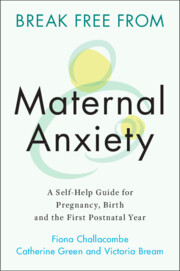61 results
Chapter 8 - Myths About Disasters
- from Section 1 - The Nature and Impacts of Twenty-First-Century Healthcare Emergencies
-
-
- Book:
- Major Incidents, Pandemics and Mental Health
- Published online:
- 11 January 2024
- Print publication:
- 01 February 2024, pp 36-41
-
- Chapter
- Export citation
12 - Collective Solidarities
-
- Book:
- COVID and Climate Emergencies in the Majority World
- Published online:
- 22 June 2023
- Print publication:
- 06 July 2023, pp 110-115
-
- Chapter
- Export citation
5 - Panic Attacks and Health Worries
-
- Book:
- Break Free from Maternal Anxiety
- Published online:
- 13 October 2022
- Print publication:
- 13 October 2022, pp 116-147
-
- Chapter
- Export citation
1 - Introduction
-
- Book:
- Break Free from Maternal Anxiety
- Published online:
- 13 October 2022
- Print publication:
- 13 October 2022, pp 1-16
-
- Chapter
- Export citation

Break Free from Maternal Anxiety
- A Self-Help Guide for Pregnancy, Birth and the First Postnatal Year
-
- Published online:
- 13 October 2022
- Print publication:
- 13 October 2022
Chapter 7 - Anxiety Disorders in Evolutionary Perspective
-
-
- Book:
- Evolutionary Psychiatry
- Published online:
- 08 September 2022
- Print publication:
- 29 September 2022, pp 101-116
-
- Chapter
- Export citation
Level of Fear in Front-Line Nurses During the COVID-19 Pandemic, a Cross-Sectional Study in Iran
-
- Journal:
- Disaster Medicine and Public Health Preparedness / Volume 17 / 2023
- Published online by Cambridge University Press:
- 19 July 2022, e206
-
- Article
- Export citation
Session 11 - Anger and Anger Protocol
-
- Book:
- Multiplex CBT for Traumatized Multicultural Populations
- Published online:
- 22 May 2022
- Print publication:
- 16 June 2022, pp 136-141
-
- Chapter
- Export citation
Session 4 - Education About Trauma and Introduction of the Trauma-Recall Protocol (TRP)
-
- Book:
- Multiplex CBT for Traumatized Multicultural Populations
- Published online:
- 22 May 2022
- Print publication:
- 16 June 2022, pp 53-60
-
- Chapter
- Export citation
Session 3 - Review of the Toe-to-Head Muscle Relaxation with Visualization and the Introduction of the Anxiety Protocol
-
- Book:
- Multiplex CBT for Traumatized Multicultural Populations
- Published online:
- 22 May 2022
- Print publication:
- 16 June 2022, pp 45-52
-
- Chapter
- Export citation
Session 13 - Somatic Symptoms II and Review
-
- Book:
- Multiplex CBT for Traumatized Multicultural Populations
- Published online:
- 22 May 2022
- Print publication:
- 16 June 2022, pp 152-161
-
- Chapter
- Export citation
Session 2 - Applied Stretching and the Toe-to-Head Muscle Relaxation with Visualization
-
- Book:
- Multiplex CBT for Traumatized Multicultural Populations
- Published online:
- 22 May 2022
- Print publication:
- 16 June 2022, pp 37-44
-
- Chapter
- Export citation
Session 7 - Interoceptive Exposure with Reassociation II: Hyperventilation
-
- Book:
- Multiplex CBT for Traumatized Multicultural Populations
- Published online:
- 22 May 2022
- Print publication:
- 16 June 2022, pp 84-96
-
- Chapter
- Export citation
Session 10 - Worry and Generalized Anxiety Disorder
-
- Book:
- Multiplex CBT for Traumatized Multicultural Populations
- Published online:
- 22 May 2022
- Print publication:
- 16 June 2022, pp 122-135
-
- Chapter
- Export citation
Session 6 - Interoceptive Exposure with Reassociation I: Head Rotation
-
- Book:
- Multiplex CBT for Traumatized Multicultural Populations
- Published online:
- 22 May 2022
- Print publication:
- 16 June 2022, pp 72-83
-
- Chapter
- Export citation
Session 12 - Somatic Symptoms I and Review
-
- Book:
- Multiplex CBT for Traumatized Multicultural Populations
- Published online:
- 22 May 2022
- Print publication:
- 16 June 2022, pp 142-151
-
- Chapter
- Export citation
Session 5 - Education About Trauma-Related Disorder, Modification of Catastrophic Cognitions, and Teaching Emotional Distancing
-
- Book:
- Multiplex CBT for Traumatized Multicultural Populations
- Published online:
- 22 May 2022
- Print publication:
- 16 June 2022, pp 61-71
-
- Chapter
- Export citation
Therapist Introduction
-
- Book:
- Multiplex CBT for Traumatized Multicultural Populations
- Published online:
- 22 May 2022
- Print publication:
- 16 June 2022, pp 1-24
-
- Chapter
- Export citation
Session 9 - Sleep Disturbance
-
- Book:
- Multiplex CBT for Traumatized Multicultural Populations
- Published online:
- 22 May 2022
- Print publication:
- 16 June 2022, pp 109-121
-
- Chapter
- Export citation
Session 8 - Education About Breathing and Its Use for Relaxation
-
- Book:
- Multiplex CBT for Traumatized Multicultural Populations
- Published online:
- 22 May 2022
- Print publication:
- 16 June 2022, pp 97-108
-
- Chapter
- Export citation



